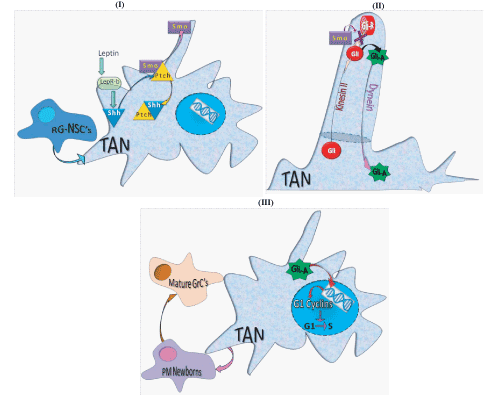
(I) Signals from Lep•LepR-b complexes stimulate the production of Sonic hedgehog (Shh), which in turn causes Ptch (Patched) to leave the cilium. The key player in this mechanism is Gli, which is carried to the cilium tip and its processing machinery along the cilial microtubule trackway (the axoneme) by the kinesin-II carrier.
(II) In the presence of Ptch and the absence of Shh, Gli is processed by the tip machinery into Gli-R, its transcription repressor form [26]. But the Shh-driven exit of Ptch releases Smo’s (Smoothened), which move up to the cilium’s tip and enable the formation of Gli-A, the gene-activating form of Gli that is then transported down the trackway by the dynein carrier, and passes through the cilium’s basal barrier.
(III) Gli-A then moves to the nucleus, where it stimulates the expression of the cyclins D and E for the cyclin-dependent protein kinase engines that drive the key stages of the pre-replicative build-up to DNA replication. Upon reaching the end of the transit amplifying part of the neuronal maturation program, the accumulated TAN’s shut down their proliferative cycling machinery and become post-mitotic (PM) Newborns, which progressively mature and, if lucky enough to survive, become fully Mature GrC’s that enter the GrC layer of the SVZ and join the veteran GrC’s that process the data converging on the DG from the various regions of the neocortex.